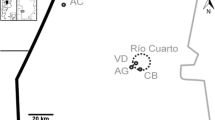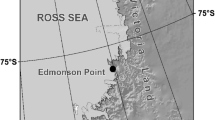Abstract
Birds have the potential to be considered valuable bioindicators of the quality of ecosystems and the environmental impact of pollutants. The aims of this study were to determine the micronuclei frequency and other nuclear abnormalities in erythrocytes by analyzing a wild bird community from central Monte desert (Argentina) and to clarify if there were any differences among certain species. Frequencies of nuclear abnormalities were determined in 73 wild birds belonging to 17 species and two orders (Passeriformes and Columbiformes). A high proportion of individuals, 90.4 and 80.9 %, had erythrocytes with micronuclei and nuclear buds, respectively. Notched nuclei, binucleated cells, nuclear tails, and nucleoplasmic bridges were also recorded. Certain species appeared to be more informative than others with regard to the possibility of being used as bioindicators of genetic damage. Saltator aurantiirostris and Columbina picui were the only species that showed significantly different frequencies of nuclear alterations, in comparison with the other species. The frequencies here presented are the first reported for these bird species from the orders Passeriformes and Columbiformes. This research supports the notion that the use of these biomarkers could be effectively applied to evaluate spontaneous or induced genetic instability in wild birds.


Similar content being viewed by others
References
Adams SM, Giesy JP, Tremblay LA, Eason CT (2001) The use of biomarkers in ecological risk assessment: recommendation from the Christchurch conference on biomarkers in ecology. Biomarkers 6(1):1–6
Alimba CG, Bakare AA (2015) In vivo micronucleus test in the assessment of cytogenotoxicity of landfill leachates in three animal models from various ecological habitats. Ecotoxicology. doi:10.1007/s10646-015-1589-3
Anbumani S, Mohankumar MN (2015) Nucleoplasmic bridges and tailed nuclei are signatures of radiation exposure in Oreochromis mossambicus using erythrocyte micronucleus cytome assay (EMNCA). Environ Sci Pollut Res 22:18425–18436. doi:10.1007/s11356-015-5107-1
Baesse CQ, Tolentino VCM, Silva AM, Silva AA, Ferreira GA, Paniago LPM, Nepomuceno JC, Melo C (2015) Micronucleus as biomarker of genotoxicity in birds from Brazilian Cerrado. Ecotoxicol Environ Saf 115:223–228. doi:10.1016/j.ecoenv.2015.02.024
Baršienė J, Rybakovas A, Lang T, Andreikėnaitė L, Michailovas A (2013) Environmental genotoxicity and cytotoxicity levels in fish from the North Sea offshore region and Atlantic coastal waters. Mar Pollut Bull 68:106–116. doi:10.1016/j.marpolbul.2012.12.011
Bird DM, Bildstein KL (eds) (2007) Raptor research and management techniques. Hancock House Publishers LTD, Surrey, B.C.
Bonassi S, Au WW (2002) Biomarkers in molecular epidemiology studies for health risk prediction. Mutat Res 511(1):73–86
Bonisoli-Alquati A (2014) Avian genetic ecotoxicology: DNA of the canary in a coalmine. Current Zoology 60(2):285–298
Bosch B, Mañas F, Gorla N, Aiassa D (2011) Micronucleus test in post metamorphic Odontophrynus cordobae and Rhinella arenarum (Amphibia: Anura) for environmental monitoring. Journal of Toxicology and Environmental Health Sciences 6(3):155–163
Boshoven J, Tognelli M (2001) El desierto del monte: la reserva de biosfera de Ñacuñán. Ed. Triunfar, Argentina
Burns KJ, Shultz AJ, Title PO, Mason NA, Barker FK, Klicka J, Lanyon SM, Lovette IJ (2014) Phylogenetics and diversification of tanagers (Passeriformes: Thraupidae), the largest radiation of Neotropical songbirds. Mol Phylogenet Evol 75:41–77. doi:10.1016/j.ympev.2014.02.006
Carrasco KR, Tilbury KL, Myers MS (1990) Assessment of the piscine micronucleus test as an in situ biological indicator of chemical contaminant effects. Can J Fish Aquat Sci 47:2123–2136
Çavaş T, Ergene-Gözükara S (2005) Micronucleus test in fish cells: a bioassay for in situ monitoring of genotoxic pollution in the marine environment. Environ Mol Mutagen 46:64–70. doi:10.1002/em.20130
Clark P (2015) Assessment of avian erythrocytes that exhibit variant nuclear morphology. Comp Clin Pathol 24:485–490. doi:10.1007/s00580-014-1926-6
Cueto VR, Lopez de Casenave J (2007) Reserva de Biosfera de Ñacuñan. In: Di Giacomo AS, De Francesco MV, Coconier EG (eds) Áreas importantes para la conservación de las aves en Argentina. Sitios prioritarios para la conservación de la biodiversidad. Temas de Naturaleza y Conservación N°5. Edición Revisada y Corregida. Aves Argentinas/Asociación Ornitológica del Plata, Buenos Aires, pp. 266–267
Da Silva Souza T, Fontanetti CS (2006) Micronucleus test and observation of nuclear alterations in erythrocytes of Nile tilapia exposed to waters affected by refinery effluent. Mutation Research/Genetic Toxicology and Environmental Mutagenesis 605:87–93. doi:10.1016/j.mrgentox.2006.02.010
De Mas E, Benzal J, Merino S, Valera F, Palacios MJ, Cuervo JJ, Barbosa A, et al. (2015) Erythrocytic abnormalities in three Antarctic penguin species along the Antarctic peninsula: biomonitoring of genomic damage. Polar Biol. doi:10.1007/s00300-015-1667-2
Fenech M, Bolognessi C, Kirsch-Volders M, Bonassi S, Zeiger E, Knesmüller S, Holland N (2006) Harmonisation of the micronucleus assay in human buccal cells—a human micronucleus (HUMN) project (www.humn.org) initiative commencing in 2007. Mutagenesis 22(1):3–4
Fenech M, Kirsch-Volders M, Natarajan AT, Surralles J, Crott JW, Parry J, Norppa H, Eastmond DA, Tucker JD, Thomas P (2011) Molecular mechanisms of micronucleus, nucleoplasmic bridge and nuclear bud formation in mammalian and human cells. Mutagenesis 26(1):125–132
Fox GA (2001) Wildlife as sentinels of human health effects in the Great Lakes-St. Lawrence Basin. Environ Health Perspect 109(6):853–861
Gómez-Meda BC, Zamora-Perez AL, Luna-Aguirre J, González-Rodríguez A, Ramos-Ibarra ML, Torres-Bugarín O, Batista-González CM, Zúñiga-González GM (2006) Nuclear abnormalities in erythrocytes of parrots (Aratinga canicularis) related to genotoxic damage. Avian Pathology 35:206–210. doi:10.1080/03079450600711003
Harabawy ASA, Mosleh YYI (2014) The role of vitamins A, C, E and selenium as antioxidants against genotoxicity and cytotoxicity of cadmium, copper, lead and zinc on erythrocytes of Nile tilapia, Oreochromis niloticus. Ecotoxicol Environ Saf 104:28–35. doi:10.1016/j.ecoenv.2014.02.015
Hatch EM, Fischer AH, Deerinck TJ, Hetzer MW (2013) Catastrophic nuclear envelope collapse in cancer cell micronuclei. Cell 154:47–60. doi:10.1016/j.cell.2013.06.007
Hussain R, Mahmood F, Khan A, Javed MT, Rehan S, Mehdi T (2012) Cellular and biochemical effects induced by atrazine on blood of male Japanese quail (Coturnix japonica). Pestic Biochem Physiol 103:38–42. doi:10.1016/j.pestbp.2012.03.001
Ilyinskikh NN, Ilyinskikh EN, Ksenz AS, Yurkin AY (1997) An assessment of frequencies of micronucleated erythrocytes in peripheral blood of pigeons (Columba livia gm) living in the polluted radioactive area around the siberian chemical plant. Environ Pollut 98(1):119–122
Jindal R, Verma S (2015) In vivo genotoxicity and cytotoxicity assessment of cadmium chloride in peripheral erythrocytes of Labeo rohita (Hamilton). Ecotoxicol Environ Saf 118:1–10. doi:10.1016/j.ecoenv.2015.04.005
Jones MP (2015) Avian hematology. Clin Lab Med 35:649–659. doi:10.1016/j.cll.2015.05.013
Kursa M, Bezrukov V (2007) Health status in an antartic top predator: micronuclei frequency and white blood cell differential in the south polar skua (Catharacta maccormicki). Polarforschung 77(1):1–5
Kursa M, Afanasieva K, Rushkovsky S, Barchuk R, Varenyuk I, Blyuma O, Bezrukov V (2005) Cytogenetic parameters of the bird genome instability in the ecological-genetic monitoring. Problems of Nuclear Power Plants’ Safety of Chernoby l3(2):92–96
Poletta GL, Larriera A, Kleinsorge E, Mudry MD (2008) Caiman latirostris (broad-snouted caiman) as a sentinel organism for genotoxic monitoring: basal values determination of micronucleus and comet assay. Mutation Research/Genetic Toxicology and Environmental Mutagenesis 650:202–209. doi:10.1016/j.mrgentox.2007.12.001
Rabinowitz PM, Scotch ML, Conti LA (2010) Animals as sentinels: using comparative medicine to move beyond the laboratory. ILAR J 51:262–267. doi:10.1093/ilar.51.3.262
Ralph CJ, Geupel GR, Pyle P, Martin TE, DeSante DF, Milá B (1996) Manual de métodos de campo para el monitoreo de aves terrestres. Pacific Southwest Research Station, Albany
Remsen JV, Areta Jr JI, Cadena CD, Jaramillo A, Nores M, Pacheco JF, Pérez-Emín J, Robbins MB, Stiles FG, Stotz DF, Zimmer KJ (2015) A classification of the bird species of South America. American Ornithologists’ Union. http://www.museum.lsu.edu/~Remsen/SACCBaseline.html
Schaumburg LG, Poletta GL, Siroski PA, Mudry MD (2012) Baseline values of micronuclei and comet assay in the lizard Tupinambis merianae (Teiidae, Squamata). Ecotoxicol Environ Saf 84:99–103. doi:10.1016/j.ecoenv.2012.06.023
Sharaf S, Khan A, Khan MZ, Aslam F, Saleemi MK, Mahmood F (2010) Clinico-hematological and micronuclear changes induced by cypermethrin in broiler chicks: their attenuation with vitamin E and selenium. Exp Toxicol Pathol 62:333–341. doi:10.1016/j.etp.2009.05.002
Shepherd GL, Somers CM (2012) Adapting the buccal micronucleus cytome assay for use in wild birds: age and sex affect background frequency in pigeons. Environ Mol Mutagen 53:136–144. doi:10.1002/em.21673
Skarphedinsdottir H, Hallgrimsson GT, Hansson T, Hägerroth PÄ, Liewenborg B, Tjärnlund U, Äkerman G, Baršiené J, Balk L (2010) Genotoxicity in herring gulls (Larus argentatus) in Sweden and Iceland. Mutation Research/Genetic Toxicology and Environmental Mutagenesis 702:24–31. doi:10.1016/j.mrgentox.2010.07.002
Stahl RG Jr (1997) Can mammalian and non-mammalian “sentinel species”; data be used to evaluate the human health implications of environmental contaminants? Hum Ecol Risk Assess 3(3):329–335
Stončius D, Lazutka JR (2003) Spontaneous and benzo[a]pyrene-induced micronuclei in the embryos of the black-headed gull (Larus ridibundus L.). Mutation Research/Genetic Toxicology and Environmental Mutagenesis 538:31–39. doi:10.1016/S1383-5718(03)00092-5
Stončius D, Sinkevičius S (2003) Spontaneous micronuclei in the black-headed gull (Larus ridibundus L.) embryos in relation to parameters determining nestling survival. Acta Zoologica Lituanica 13(3):294–298
Thomas P, Holland N, Bolognesi C, Kirsch-Volders M, Bonassi S, Zeiger E, Knasmueller S, Fenech M (2009) Buccal micronucleus cytome assay. Nat Protoc 4:825–837. doi:10.1038/nprot.2009.53
Tolbert PE, Shy CM, Allen JW (1992) Micronuclei and other nuclear anomalies in buccal smears: methods development. Mutat Res 271:69–77
Van der Oost R, Beyer J, Vermeulen NP (2003) Fish bioaccumulation and biomarkers in environmental risk assessment: a review. Environ Toxicol Pharmacol 13:57–149. doi:10.1016/S1382-6689(02)00126-6
Van Gestel C, Van Brummelen T (1996) Incorporation of the biomarker concept in ecotoxicology calls for a redefinition of terms. Ecotoxicology 5:217–225
Yu J, Dong H-W, Shi L-T, Jiang HL, Yu JW, Zhao QW, Cai SC, Han D, Tang XY, Liu JR (2013) Re-examination of the genotoxic activity of water taken from the Songhua River in P.R. China. Arch Environ Contam Toxicol 65:78–88. doi:10.1007/s00244-013-9876-6
Zúñiga-González G, Torres-Bugarín O, Luna-Aguirre J, González-Rodrígez A, Zamora-Pérez A, Gómez-Meda BC, Ventura-Aguilar AJ, Ramos-Ibarra ML, Ramos-Mora A, Ortíz GG, Gallegos-Arreola MP (2000) Spontaneous micronuclei in peripheral blood erythrocytes from 54 animals species (mammals, reptiles and birds): part two. Mutat Res 467:99–103
Zúñiga-González G, Torres-Bugarín O, Zamora-Pérez A, Gómez-Meda BC, Ramos Ibarra ML, Martínez-González S, González-Rodríguez A, Luna-Aguirre J, Ramos-Mora A, Ontiveros-Lira D, Gallegos-Arreola MP (2001) Differences on the number of micronucleated erythrocytes among young and adult animals including humans. Spontaneous micronuclei in 43 species. Mutat Res 494:161–167
Acknowledgments
The authors appreciate the technical assistance of Mr. Marcelo J Tornello, Lic. Ania R Gil, and Mr. Esteban Rosales; to Dr. Victor Cueto by the loan of the mist nets; and to Universidad Juan Agustín Maza (Mendoza) and Consejo Nacional de Investigaciones Científicas y Técnicas (CONICET) for the financial support.
Author information
Authors and Affiliations
Corresponding author
Ethics declarations
Procedure protocols performed in studies involving animals were approved by the Institutional Commission for the Care and Use of Laboratory Animals (Universidad Juan Agustín Maza).
Conflict of interest
The authors declare that there they have no conflict of interest.
Additional information
Responsible editor: Philippe Garrigues
Electronic supplementary material
ESM 1
Frequency of micronuclei per 1000 cells. Abbreviations: Colpic, Columbina picui; Elaalb, Elaenia albiceps; Pooorn, Poospiza ornata; Pootor, Poospiza torquata; Salaur, Saltator aurantiirostris; Salmur, Saltatricula multicolor; Zoncap, Zonotrichia capensis. (GIF 3 kb)
ESM 2
Frequency of nuclear buds per 1000 cells. Abbreviations: Colpic, Columbina picui; Elaalb, Elaenia albiceps; Pooorn, Poospiza ornata; Pootor, Poospiza torquata; Salaur, Saltator aurantiirostris; Salmur, Saltatricula multicolor; Zoncap, Zonotrichia capensis. (GIF 2 kb)
ESM 3
Frequency of notched nuclei per 1000 cells. Abbreviations: Colpic, Columbina picui; Elaalb, Elaenia albiceps; Pooorn, Poospiza ornata; Pootor, Poospiza torquata; Salaur, Saltator aurantiirostris; Salmur, Saltatricula multicolor; Zoncap, Zonotrichia capensis. (GIF 2 kb)
ESM 4
Frequency of binucleated cells per 1000 cells. Abbreviations: Colpic, Columbina picui; Elaalb, Elaenia albiceps; Pooorn, Poospiza ornata; Pootor, Poospiza torquata; Salaur, Saltator aurantiirostris; Salmur, Saltatricula multicolor; Zoncap, Zonotrichia capensis. (GIF 2 kb)
ESM 5
Frequency of nuclear tails per 1000 cells. Abbreviations: Colpic, Columbina picui; Elaalb, Elaenia albiceps; Pooorn, Poospiza ornata; Pootor, Poospiza torquata; Salaur, Saltator aurantiirostris; Salmur, Saltatricula multicolor; Zoncap, Zonotrichia capensis. (GIF 2 kb)
ESM 6
Frequency of nucleoplasmic bridges per 1000 cells. Abbreviations: Colpic, Columbina picui; Elaalb, Elaenia albiceps; Pooorn, Poospiza ornata; Pootor, Poospiza torquata; Salaur, Saltator aurantiirostris; Salmur, Saltatricula multicolor; Zoncap, Zonotrichia capensis. (GIF 2 kb)
Rights and permissions
About this article
Cite this article
Quero, A.A.M., Ferré, D.M., Zarco, A. et al. Erythrocyte micronucleus cytome assay of 17 wild bird species from the central Monte desert, Argentina. Environ Sci Pollut Res 23, 25224–25231 (2016). https://doi.org/10.1007/s11356-016-7638-5
Received:
Accepted:
Published:
Issue Date:
DOI: https://doi.org/10.1007/s11356-016-7638-5




